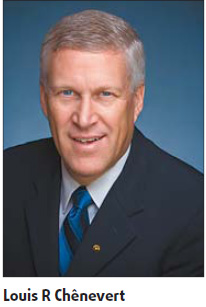|
Louis R. Chênevert, president and CEO of United Technologies Corp (UTC), has been to China more than 40 times since the early 1990s - and for good reason.
With a history in the nation dating back more than a century, the US industrial conglomerate is now one of the largest international investors in China.
Its subsidiary Otis installed its first elevator in Hong Kong in 1888 and in Shanghai in 1907. Another of its companies, Carrier air conditioning systems, arrived in the early 1930s.
Today all of UTC's subsidiaries are operating in China, including Otis, Carrier, Hamilton Sundstrand aerospace, Pratt & Whitney aircraft engines, Sikorsky helicopters, UTC Fire & Security, UTC Power and United Technologies Research Center.
"I enjoy coming to China as the development pace here is remarkable," Chênevert said. "Our growth in China outpaces any of our other markets."

Today UTC has established more than 40 joint ventures in the country that together have more than 16,000 employees. Its revenue in China last year totaled 19 billion yuan, about 5 percent of its global sales, said Chênevert.
As it is a leading equipment supplier in the building industry, UTC knows urbanization in emerging markets is an enormous opportunity, with China's surging building market growing in importance to the company, said Chênevert.
The CEO noted another priority, energy efficiency, for which UTC is well-positioned in China as it continues to bring green technologies and solutions to the market.
Working in China for more than a century, UTC has localized much of its manufacturing. Today 95 percent of Otis elevators delivered to domestic customers are produced in China.
The company is also attaching more importance to local research and development (R&D). In 1997 the United Technologies Research Center (UTRC) founded its Shanghai office.
UTRC China has since been recognized by the Chinese government for excellence and is working closely with top Chinese universities including Tsinghua, Tongji, Shanghai Jiaotong and Xi'an Jiaotong.
Aviation industry
According to Chênevert, in the next 20 years more than 40 percent of the world's airline traffic will begin and end in the Asia-Pacific region.
"Asia-Pacific will become the world's largest market for aviation over the next few decades," he said. "I am proud that we are now in a good position in China's aviation industry."
On Sept 24, UTC's Pratt & Whitney and its joint venture partner China Eastern Airlines opened an engine overhaul facility in Shanghai.
The Shanghai engine center has capacity to overhaul up to 300 engines annually, with nearly 100 engine overhauls expected next year. Within three years, the center will service CFM56-3, 5B and 7 engines and employ 800 people.
The building was designed and built to meet the US Green Building Council's Leadership in Energy and Environmental Design (LEED) platinum standard, a widely accepted benchmark for design, construction and operation of high-performance green buildings.
As an environmentally friendly plant, at least 3 percent of the facility's energy will be produced from on-site renewable sources including solar thermal, solar electric and wind power. High performance, energy-efficient windows will provide daylight to the facility and cut electrical lighting requirements while reducing the need for additional cooling.
Green solutions
Many of UTC's green products have been chosen for iconic projects in China. At the Shanghai 2010 World Expo, three of its five permanent venues - Expo Boulevard, World Expo Center and Theme Pavilions - have selected Carrier's high performance building solutions.
Carrier's solutions include river source heat pump systems, ice storage technology, chilled water storage technology, high efficiency variable frequency centrifugal chillers and high efficiency air-cooled screw heat pumps. They meet demands for non-ozone depleting, energy-efficient and cost-effective operations in Expo venues.
UTC not only provides green products and green solutions, every facility under the company has a mandate to be designed with energy efficiency and environmental sustainability mind, said Chênevert.
One example is the Otis Elevator Company TEDA Center in Tianjin that has achieved gold-level LEED certification through technologies that reduce site energy use by at least 25 percent.
The office building features extensively insulated, reflective cool roofs to reduce heat island effects, high performance lighting, radiant heating, and a demand-controlled ventilation system with CO2 sensors to ensure a quality indoor environment.
(China Daily 10/16/2009 page15)
|

